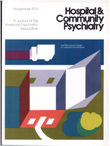Perceptual Factors in the Design of Environments for the Mentally III
Abstract
Administrators and others responsible for the design of environments for the mentally ill must be aware that what might be considered irrelevant minutiae of design can have traumatic effects on patients. Because of patients' heightened sensitivity to sensory stimuli and their lessened ability to filter out or adjust to the effects of such stimuli, they are much more likely to be affected by their surroundings than are healthier people, and their social relationships are correspondingly affected. The author describes several kinds of visual, auditory, olfactory, and other stimuli that lead to distorted perceptions of oneself and others and of time and space. He recommends not a bland and stimulus-free environment, but one whose elements are unobtrusive and unambiguous.
Access content
To read the fulltext, please use one of the options below to sign in or purchase access.- Personal login
- Institutional Login
- Sign in via OpenAthens
- Register for access
-
Please login/register if you wish to pair your device and check access availability.
Not a subscriber?
PsychiatryOnline subscription options offer access to the DSM-5 library, books, journals, CME, and patient resources. This all-in-one virtual library provides psychiatrists and mental health professionals with key resources for diagnosis, treatment, research, and professional development.
Need more help? PsychiatryOnline Customer Service may be reached by emailing [email protected] or by calling 800-368-5777 (in the U.S.) or 703-907-7322 (outside the U.S.).



